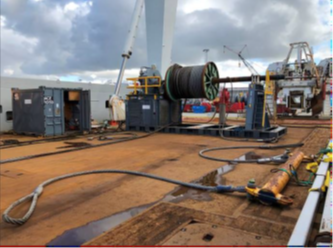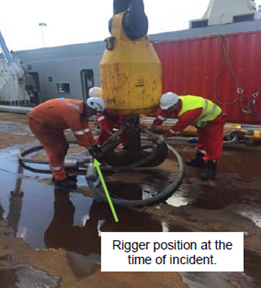Serious injury incurred while removing wire rope sling from a crane hook
A rigger sustained a fractured shoulder whilst removing a large diameter wire rope sling soft eye from the crane hook.
During vessel mobilisation of deck equipment, crew were lifting a wire drum onto a spooling winch. After landing the wire drum onto the spooler, deck crew landed the spreader beam onto the deck and started disconnection of both spreader beam wire rope slings from the crane hook. The crane hook was positioned at waist height to assist with manual handling. The first wire rope sling was disconnected without incident. On attempting to remove the second wire rope sling, it rapidly rose up and struck the rigger on his right shoulder forcing him backwards and causing him to fall to the deck, causing a serious injury to his shoulder.


Findings
- There was no Task Risk Assessment and Toolbox Talk for what was a non-routine lift;
- The crane hook was at waist height and kept in proximity to the spreader beam to assist manual handling; this introduced a bend in the wire rope sling with possible torsion which introduced an unknown amount of stored energy;
- During the task, the rigger acknowledged the advice from the Deck Foreman to watch out for stored energy but did not appreciate the potential risk from this and continued working.
Actions taken? Lessons learned?
- Raise awareness of the critical need for a time out before starting non-routine activities;
- Ensure that Task Risk Assessments and Toolbox Talks include everyone involved in the lifting operation and that they are fully aware of the inherent risks;
- Whilst removing wire rope slings from crane hooks, it is recognised that there will be many different situations. In most cases, however, the crane hook should be landed on the deck before disconnecting the slings;
- Reinforce with riggers and personnel involved in lifting operations the need to remain aware of the potential hazard of stored energy in large steel wire rope slings when disconnecting them from the crane hook and during general wire rope handling activities.
Members may wish to refer to
Members may also wish to refer to
- IMCA Guidelines for lifting operations
- Line of fire (‘Be prepared to work safely’ video)
- In the line of fire(IMCA SEL 036, classic safety video)
Safety Event
Published: 10 November 2020
Download: IMCA SF 31/20
IMCA Safety Flashes
Submit a Report
IMCA Safety Flashes summarise key safety matters and incidents, allowing lessons to be more easily learnt for the benefit of all. The effectiveness of the IMCA Safety Flash system depends on Members sharing information and so avoiding repeat incidents. Please consider adding [email protected] to your internal distribution list for safety alerts or manually submitting information on incidents you consider may be relevant. All information is anonymised or sanitised, as appropriate.
IMCA’s store terms and conditions (https://www.imca-int.com/legal-notices/terms/) apply to all downloads from IMCA’s website, including this document.
IMCA makes every effort to ensure the accuracy and reliability of the data contained in the documents it publishes, but IMCA shall not be liable for any guidance and/or recommendation and/or statement herein contained. The information contained in this document does not fulfil or replace any individual’s or Member's legal, regulatory or other duties or obligations in respect of their operations. Individuals and Members remain solely responsible for the safe, lawful and proper conduct of their operations.
